
Most people know that copying someone else’s work and passing it off as their own is plagiarism. But plagiarism appears in many forms, some of which are really difficult to spot.
One common type of plagiarism is incremental plagiarism, or small pieces that are plagiarized throughout a work.
Today, we’re covering exactly what incremental plagiarism is, what it looks like in real world examples, how it differs from other types of plagiarism, and how you can avoid it in your own work.
What Is Incremental Plagiarism?
Incremental plagiarism occurs in “increments” or small pieces at a time. Usually, most of the writing is original with occasional plagiarized sections scattered throughout the piece.
Let’s take a look at the definition of incremental plagiarism in more detail.
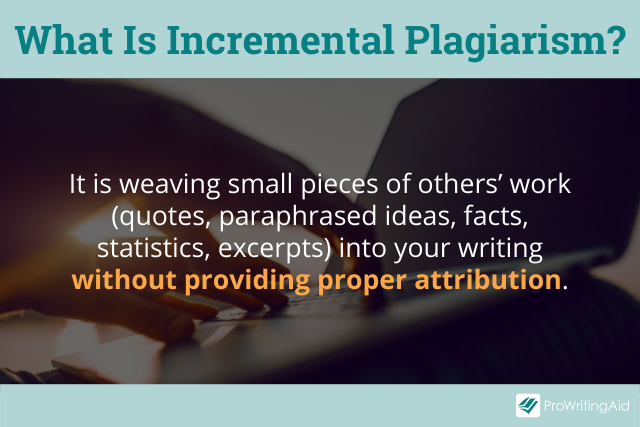
Incremental Plagiarism Definition
Incremental plagiarism means weaving quotes, excerpts, copied data, or paraphrased ideas into a piece of writing without giving proper credit to the source material.
Incremental plagiarism can take the form of verbatim plagiarism, self plagiarism, or paraphrased plagiarism.
Verbatim plagiarism means using something word for word without giving credit.
Usually, we put exact quotes in quotation marks, but even if the quotation marks are there, you must still cite the original source.
Self plagiarism occurs when you reuse pieces of your previous work without giving credit. If you collected and published data, for example, you should cite your original work.
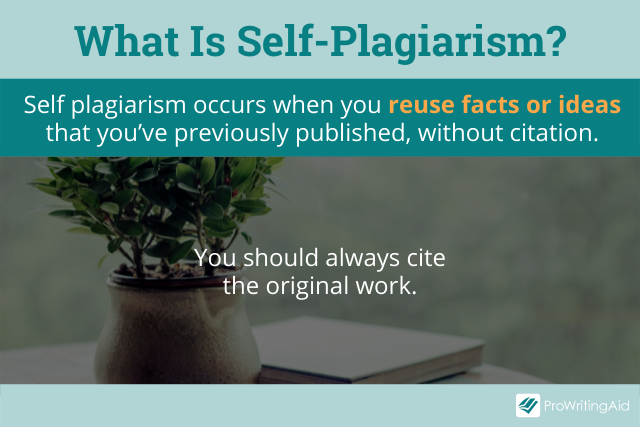
Even if you paraphrase other people’s writing and ideas, you must still give them credit. Not doing so is a common way that people commit incremental plagiarism.
Sometimes, people commit incremental plagiarism unintentionally. But even accidental plagiarism is still unethical and even illegal.
Incremental plagiarism is more subtle—and therefore easier to miss—than other types of plagiarism. This is because there is usually a fair amount of original content surrounding it.
There might be a short quote or fact that a writer forgets or chooses not to credit. A single uncredited line in a piece of writing is still incremental plagiarism.
Incremental plagiarism also occurs in public speaking. When someone finds a great quote, they might want to pass it off as their own.
It’s harder for people to realize that they’re hearing plagiarized material in a speech than when they read it.
It’s important to remove incremental plagiarism from your writing, even if it’s unintentional. Using a plagiarism checker can help find instances of plagiarism in your writing.
Incremental Plagiarism vs Global Plagiarism
Another type of plagiarism is global plagiarism. This is what many people think of when they think of plagiarizing work.
While incremental plagiarism only uses increments of other people’s work, global plagiarism means passing off someone else’s entire work as your own.
This might look like putting your name on someone else’s paper or copying their work verbatim.
It might also involve paying someone else to write your essay or copying and pasting something you found online into your assignment.
Unlike incremental plagiarism, global plagiarism has no original words or ideas.

Incremental Plagiarism vs Patchwork Plagiarism
Incremental plagiarism is easy to confuse with patchwork plagiarism.
Patchwork plagiarism means using quotes or paraphrased ideas, without attribution, and rearranging them to pass it off as original material.
Both incremental plagiarism and patchwork plagiarism involve small pieces of quoted or paraphrased material. But incremental plagiarism weaves that material into mostly original work.
With patchwork plagiarism, the stolen material makes up most of the work. But it’s easy to miss because the writer changes up the order and may use multiple sources to make it sound original.
Incremental Plagiarism Examples
Here are four famous, real-world examples of incremental plagiarism.
Political Speech
In one of the most widely talked about examples of incremental plagiarism, Melania Trump, wife of then-presidential candidate Donald Trump, gave a speech at the Republican National Convention in 2016.
People were quick to realize parts of Melania’s speech sounded familiar.
Journalist Jarret Hill was the first to bring the plagiarism to light. He realized the speech was very similar to one that former First Lady Michelle Obama had given at the 2008 Democratic National Convention.
News site The Washingtonian ran the speech through a plagiarism checker and found that 47% of the speech was plagiarized. There’s a less than one in a trillion chance that this occurred accidentally.
The Trumps never owned up to the plagiarism.
Song Lyrics
Our next two examples are both songs, and both of these went to court.
In 2007, Canadian singer-songwriter Avril Lavigne was accused of plagiarizing her song “Girlfriend.” A 1970s band called The Rubinoos said she ripped off their song “I Wanna Be Your Boyfriend.”
Lavigne claimed she had never heard the song, and apparently her manager consulted a musicologist who did not see any similarities.
Lavigne and the Rubinoos managed to reach a settlement, and the band dropped their accusations.
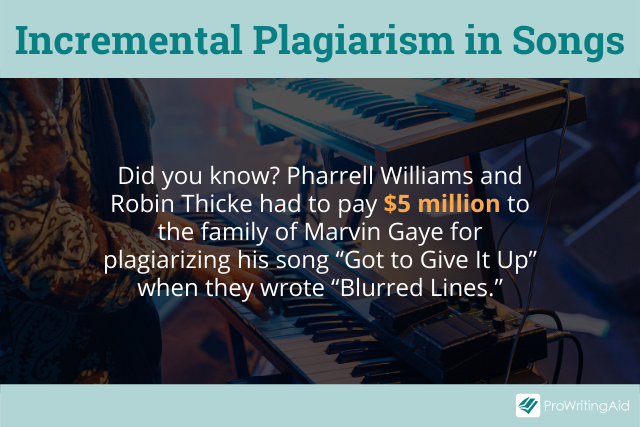
A more recent example occurred in 2018. After years of legal battles, a federal judge ordered Pharrell Williams and Robin Thicke to pay the family of Marvin Gaye $5 million.
Williams and Thicke claim the song “Blurred Lines” was inspired by Gaye’s song “Got to Give It Up,” but that they did not plagiarize it.
The Gaye family first accused Williams and Thicke in 2013. After a series of countersuits and appeals, the law ruled in favor of the Gaye family, but reduced the original requested sum of $7.4 million.
Commencement Speech
This final example started as a single incident but quickly proved to be a pattern.
In 2010, a Filipino businessman named Manny V. Pangilinan gave a commencement address at Ateneo de Manila University. He was also chair of the board of trustees of the university.
A blogger named Katrina Stuart Santiago first pointed out the incremental plagiarism in his speech.
Pangilinan stole quotes from President Barack Obama, Oprah Winfrey, Conan O’Brien, and J.K. Rowling.
Pangilinan quickly admitted his mistake and offered to resign from his position at the university, although the board did not accept his resignation.
But another blogger and author, Jessica Zafra, soon found more examples of incremental plagiarism in previous speeches by Pangilinan. Hopefully, the businessman learned his lesson.
How to Avoid Incremental Plagiarism
Accidental plagiarism happens. Sometimes, we forget that we heard or read something and subconsciously use it in our writing. Other times, we just forget to cite sources.
But it’s still important to avoid incremental plagiarism, even if it’s just an oversight. Take these following steps to avoid incremental plagiarism in your writing.
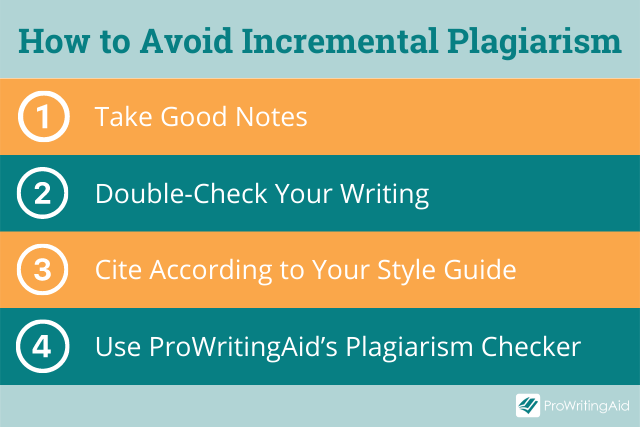
Take Good Notes
One of the best ways to avoid incremental plagiarism is to have a good note-taking system.
Taking notes of every quote, fact, data point, and paraphrased idea you have seen will prevent you subconsciously plagiarizing.
When you take notes, create a system to also keep track of your citations. This makes it easy for you to cite the original author when you’re writing.
Plus, this will help you quickly create a bibliography after you write—you’ll already have your sources written down.
Double-Check Your Writing
Hopefully, a good note-taking system will prevent any incremental plagiarism in your work. But always double check what you’ve written.
Here are some things you can ask yourself when looking for accidental plagiarism:
- Are all my quotes cited properly?
- Is this fact common knowledge or does it need a source?
- Are these ideas mine or did I paraphrase them?
- Have I given attribution for all data?
Even the facts that you might know off the top of your head may require citing. Every statistic needs a citation.
Be honest with yourself about paraphrased ideas. It’s better to give attribution than to leave it out.
Cite According to Your Style Guide
In academics especially, you can be accused of plagiarism if you fail to cite your sources properly. Pay careful attention to the style guide you are using.
Not every style guide has the same rules for attribution.
Some use parenthetical citations, while others require footnotes or endnotes. The format of those in-text citations varies between style guides, too.
Bibliographies or works cited pages also vary. If you have any questions about your style guide, look them up, or ask your teacher, a writing expert, or your editor.
Use ProWritingAid’s Plagiarism Checker
Plagiarism checkers can detect plagiarism quickly and easily. ProWritingAid has a plagiarism checker that can check your writing for instances of incremental plagiarism.
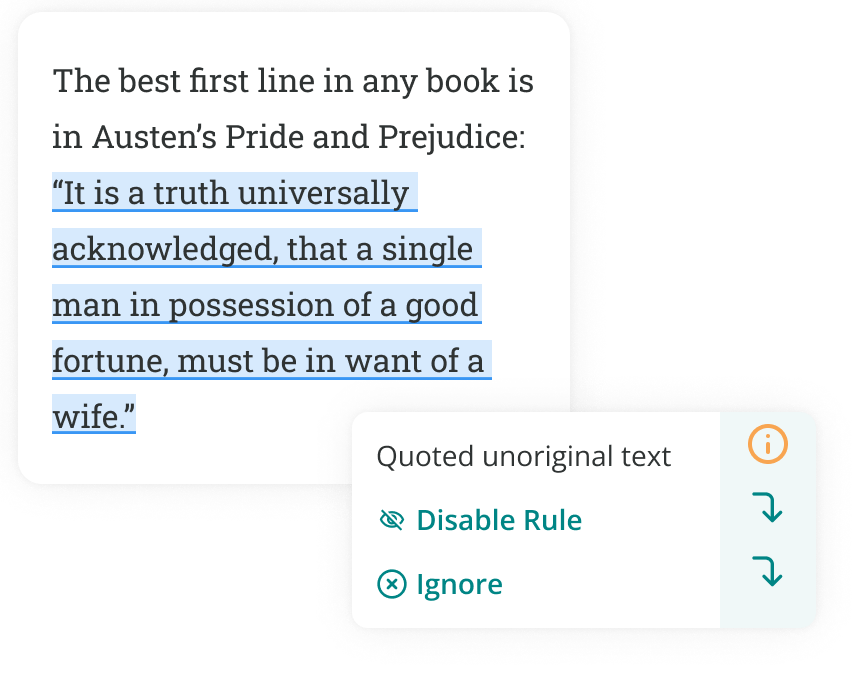
Our plans are affordable; we offer individual checks at only twenty cents.
You can run a plagiarism check right from the ProWritingAid app, making it fast and easy to avoid plagiarism.
Avoiding plagiarism doesn’t have to be difficult.
By understanding incremental plagiarism and the other types of plagiarism, you can avoid the legal action and ethical ramifications of stealing other people’s work.
Want to improve your essay writing skills?
Use ProWritingAid!
Are your teachers always pulling you up on the same errors? Maybe you’re losing clarity by writing overly long sentences or using the passive voice too much.
ProWritingAid helps you catch these issues in your essay before you submit it.


